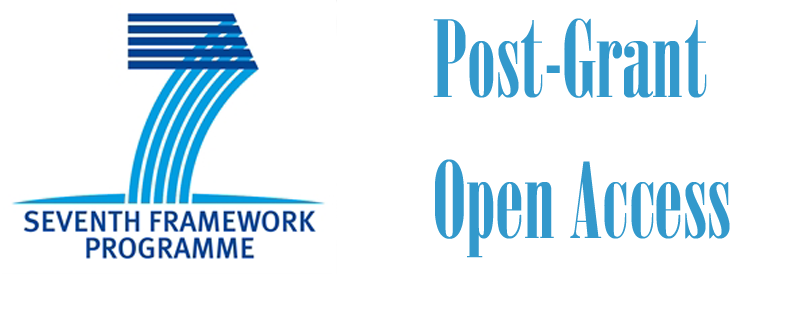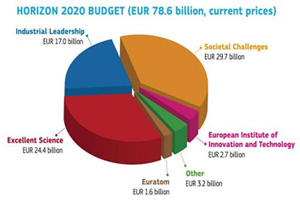
Horizon Europe may be the name for Horizon2020 successor
The European Commission has embarked on a series of research programs. Before Horizon2020 it was Framework Program (FP) 7. Then came Horizon2020 (aka FP 8) and now its end is approaching. As a result, the European Commission has been working on the next program (FP 9) that follows it. The name for the next program remained illusive. It seems the EU loved Horizon and the succeeding program might settle with Horizon affixing ‘Europe’ to its ending. That means ‘Horizon Europe’ will be the most likely name for the next program (FP 9).
The name Horizon Europe is not made public yet. It will be made public when the commission will unveil its next program (FP 9) in June, Science Business reported. Read more on Science Business

In 2015, the EU FP7 announced a post-grant pilot project to ensure all FP7 funded projects are published in open access, even after the funding program ended. The objective of this pilot project is to encourage researchers to publish their work on open access platforms. To ensure this, the EU makes post-FP7 published articles eligible for article processing charges (APCs) reimbursement. Nonetheless, this fund is primarily aimed for research grants that did not cover research publishing funds on gold open access journals.
The post-grant pilot project allows researchers and institutions to seek APCs refunding. According to this pilot project, articles and monographs are eligible for a maximum of 2,000 and 6,000 euros, respectively.
Reimbursements
The program runs until the end of April 2017. A report shows that the project has already attracted a lot of applications for reimbursement. Not all application can get approval, however. According to OpenAire, so far nearly 800 submitted requests (covering more than 500 projects) have been fully or conditionally approved for reimbursement. In total, the FP7 pilot project report shows, 950,933 EUR has been distributed. This makes the average paid 1,623 euro per publication. About 6% of the request approved came from books and monographs. The rest went to published articles.
About 58% (462) of the approved reimbursement went to five countries: Spain (168), UK (160), Italy (113), Germany (106) and the Netherlands (73). The top five journals where those articles and monographs were printed are Scientific Reports (89 publications), PLoS ONE (68), Nature Communications (40), Atmospheric Chemistry and Physics (23) and Sensors (22).
Most FP7 grants did not earmark APC funds. However, following the EU’s 2012 open access policy, the APCs became an integral part of the Horizon 2020 research grants.

All publicly-funded research to be fully accessible by 2020.
The European Competitiveness Council has announced that all publicly-funded scientific papers should be available on fully open access platforms by 2020. The council, which is chaired by the Netherlands State secretary for Education, Culture and Science and brings together ministers of science, innovation, trade and industry from the EU member states, made the announcement after a 2 day meeting in Brussels.
The EU Commissioner for science and innovation, Carlos Moedas, called the announcement a ‘life-changing’ move, as reported by Martin Enserink in The Science Magazine.
The council members reached this decision unanimously, according to a press release by the Dutch government. Mr. Sander Dekker, the council president, stated that ‘Europe must be as attractive as possible for researchers and start-ups to locate here and for companies to invest. That calls for knowledge to be freely shared. The time for talking about open access is now past. With these agreements, we are going to achieve it in practice.’
The announcement has already been endorsed by some leading open access advocates. A statement released by the League of European Research Universities (LERU) states that ‘the council’s conclusions on open science will help to create a new culture for undertaking and disseminating the results of research in the 21st century. The conclusions are appropriate and targeted, and embrace a wide range of issues which are of importance to society in the new century.’
Unanimous support
Full implementation of this ambitious plan within a short period of time – less than 4 years – may be difficult, however, and skeptics are already airing their concerns. Nonetheless, Carlos Moedas has affirmed that the EU Commission is totally committed to its implementation. The unanimous support the plan received from council members should serve as testimony to the level of political commitment there is for open access.
Policy documents previously released by the EU have demanded that all research funded by the Horizon 2020 initiative should be made open access by publishing in open journals and placing them in freely accessible repositories. However, there are no proper verification mechanisms in place to know whether researchers are complying with these policies.
References:
Enserink, M. (2016). In dramatic statement, European leaders call for ‘immediate’ open access to all scientific papers by 2020 Science DOI: 10.1126/science.aag0577
EU2016- All European scientific research to be freely accessible by 2020 (Press release)
LERU – The Dutch Presidency rises to the occasion: 15 Council conclusions that will set the way forward for R&I in the European Union (Press Release)

The European Commission (EC) inundated with a record number ofHorizon 2020 Research and Innovation applications. Just in the first round calls, the EC has received 16,000 applications. According to Robert-Jan Smits, Director–General of Research and Innovation speaking at the EuroScience Open Forum (ESOF) 2014, in Copenhagen, the number of applications received has shown growth of about a factor of nine. The Commission initially set a total of €15 billion for this round of calls. It received applications worth nine times what is allocated for, however.
The oversubscription rate of Horizon 2020 first round calls doubled that of the previous research program- the Seventh Framework Program (FP7). The success rate of Horizon 2020 applications is expected to fall to 11 percent. This is due to the surge in proposals. One reason behind driving the number of applications this time so high, Smits suggested, could be the cut in public research budgets in countries like Italy and Spain.
Horizon 2020 was designed in such a way that it brings industry back in the game. There are indications that the Commission has already registered notable success in doing this- 44 percent of the first round proposals came from industry. This is significant jump from where it was under FP7- 29 percent. Moreover, Horizon 2020 policy targets engaging Small and Medium-sized Enterprises (SMEs) companies and channeling research funding SMEs. In this front too, the policy appears to be working- half of all Horizon 2020 industry applications came from this sector.
Horizon 2020 first round calls attracted record number of women applicants. Under this program the percentage of women research applicants account for 23 percent. This shows 3 percent increase from the previous program (FP7). Rise in women participation in horizon 2020 is not only limited to proposal submission. Moreover, the percentage of women evaluating submitted proposals account for 40 percent of the evaluators. This meets the target set by the Commission.
According to Smits, research proposals oversubscription overwhelmingly came from health topics. Other oversubscribed topics are food, ICT and cyber-security.

